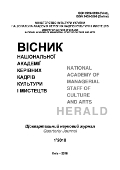THE 8-POINTED STAR (OCTAGRAM) SYMBOLOGY FROM THE PERSPECTIVE OF KARL GUSTAV JUNG
DOI:
https://doi.org/10.32461/2226-3209.1.2018.178784Анотація
Abstract. Certainly, the vast use of Islamic symbols, as well as changes in it by non-Islamic countries, has
transformed these symbols and designs. Many of our old actions and norms are modeled by the West, and have been re-introduced to our communities with the name of their cultural records. An example of the most widely used symbols is star, which has been used in different periods in architecture and in visual arts. This symbolic formulation combines the rotation of a square around itself or in some nations with a number of geometric shapes that can be explored, as well as symbolically broad implications. Identification of the origin of this symbol and its rooting has been carried out based on theological and archaic views of Karl Gustav Yung, a Swiss psychologist. His works have had a great deal of influence on the ideas and thoughts of many scholars and researchers, and his insights into the characteristics of human
personality and the status of symbols in human psychological actions have been fixed in psychology.
This article reviews The 8-Pointed STAR semiology, based on the symbolic and Archetypal theory of Karl
Gustave Jung.
Keywords: Semiology, the 8-Pointed star, Karl G. Jung.
Посилання
Ahmadi, Babak (1996), "Truth and Beauty, Center Publisher, Second Edition, p. 376
Arigal, Michael (2005), Yung and Religious Symbolism; Translator; Mohammadpour; Ahmad Reza; Review
Magazine; No. 37 and 38. From 327-328
Safety, Aaliyah (2011), "The Visual Functions of Symbols in Religious Art; Magazine of Moon Art, No. 152,
pp. 82 to 88.
Byar, Jean-Pierre; (1369), "Fire Decryption, page 28, 61
Behzadi, Roghiyeh (2001), "The Role of the Symbol in the Enlightenment of Mythology; Iranian Journal of
Studies, No. 1; pp 71 to 88.
Khayrat, F. Lakviyah, G. Dolaport, Val, (1996), "The myths of Assyria and Babylon; translated by Abolghasem Ismail Pour, Publication of the thought of day, 1 st edition, page 13
Sattari, Jalal al-Din (1348) "; Three Fundamental Concepts in Jung's Psychology; Journal of Sociological
Studies, The Old Age, No. 3, pp 127-150.
Al-Sa'id, Essam; Parman, Ayesha; (1363); Geometric roles in Islamic art; translated by Massoud Rajabnia,
Soroush publication, 1 st edition, p. 20-21.
Shayesteh Farh, Mahnaz; (2008); Inscriptions of the Vakil Mosque in Shiraz; The Monthly Art Magazine, No.
, pp 64 to 75.
Tahoori, Nair (2002) "; The golden tiles of the Mongol Ilkhan period; The Monthly Art Magazine, Nos. 45-46,
Pp 72 to 81
Cassirer, A. (1370); The Philosophy of Symbolic Faces; pp 123 to 129
Carbon, Henry; (1373); The Land of the King, the Human Body on the Day of Judgment, From Mazandai Iran
to Shiite Iran, Translated by Ziauddin Dashiri, Taheri Publishing, 2 nd Edition, pp. 62-94.
Gennon, Rennes (1374); The Meaning of Cross Crypt; Translated by Babak Alikhani, Tehran, Soroush
Publication, p. 63
Moreno, A (1370); Yung, the Gods and the modern man; page 79
NAS, John (1993); A Comprehensive History of Religions; Translated by Ali Asghar Hekmat, Islamic
Revolution Publication, 5 th Edition, p. 476
Nasr, Seyyed Hossein (1370); Qudsi art in Iranian culture; Proceedings in immortality and fashion; translated
by Seyyed Mohammad Avini, Book Publishing House, Tehran, page 41
Nosrati, Massoud (1358) "; Symbolic images in the history of historical background; Magazine of Art Month,
No. 93-94, pp 118 to 127.
Yung, Carl G; (1359); Man and his symbols; translated by Talib Saremi; Paya Publication, Second Edition, p.
-379.
Yung, Karl G (2002); Man and his Symbols; translated by Dr. Mahmood Soltanieh, Jami Publications, Tehran,
p. 314
##submission.downloads##
Номер
Розділ
Ліцензія
Автори, які публікуються у цьому журналі, погоджуються з наступними умовами:
1. Автори залишають за собою право на авторство своєї роботи та передають журналу право першої публікації цієї роботи на умовах ліцензії Creative Commons Attribution License International CC-BY, котра дозволяє іншим особам вільно розповсюджувати опубліковану роботу з обов'язковим посиланням на авторів оригінальної роботи та першу публікацію роботи у цьому журналі.
2. Автори мають право укладати самостійні додаткові угоди щодо неексклюзивного розповсюдження роботи у тому вигляді, в якому вона була опублікована цим журналом (наприклад, розміщувати роботу в електронному сховищі установи або публікувати у складі монографії), за умови збереження посилання на першу публікацію роботи у цьому журналі.
3.Політика журналу дозволяє і заохочує розміщення авторами в мережі Інтернет (наприклад, у сховищах установ або на особистих веб-сайтах) рукопису роботи, як до подання цього рукопису до редакції, так і під час його редакційного опрацювання, оскільки це сприяє виникненню продуктивної наукової дискусії та позитивно позначається на оперативності та динаміці цитування опублікованої роботи.

